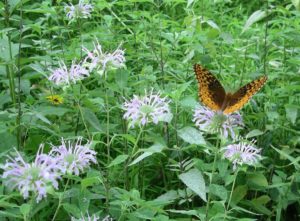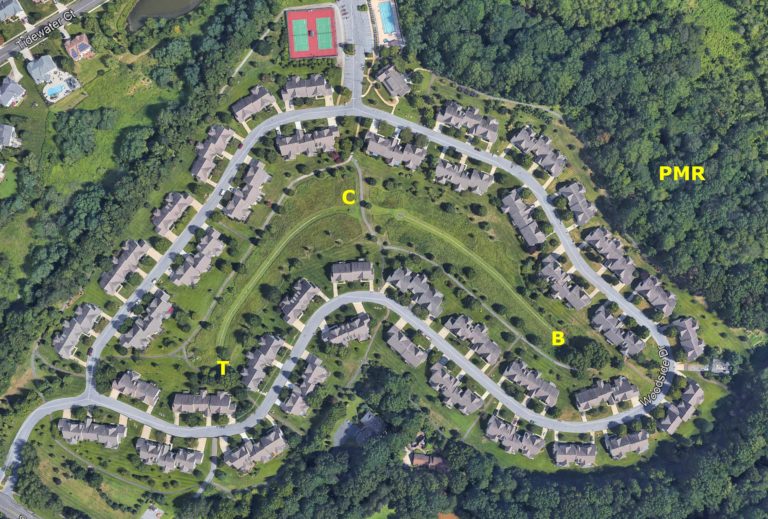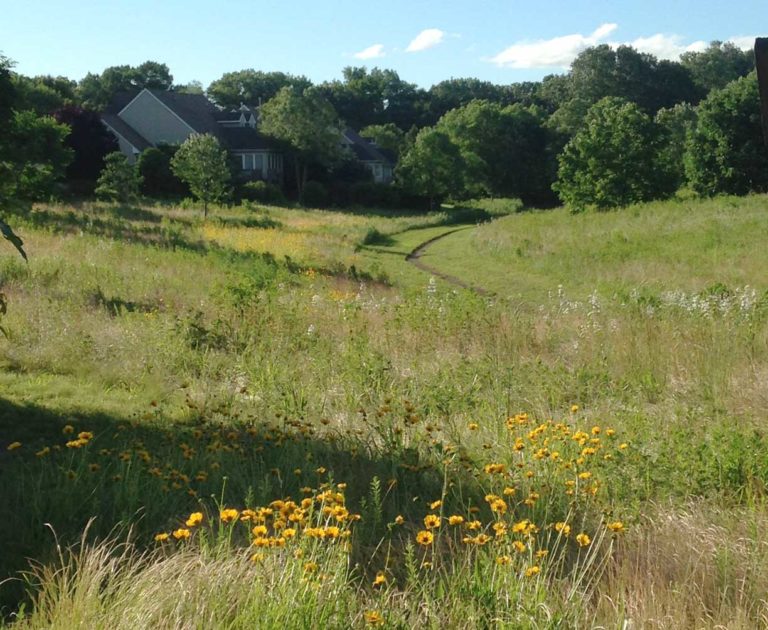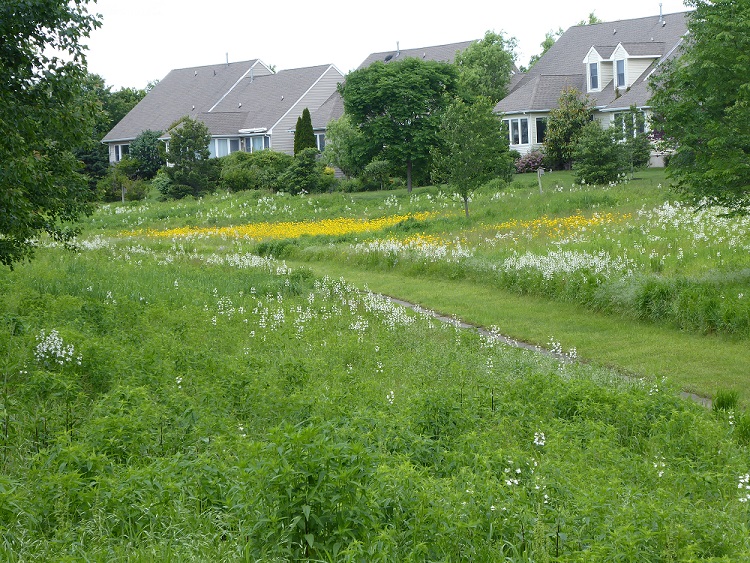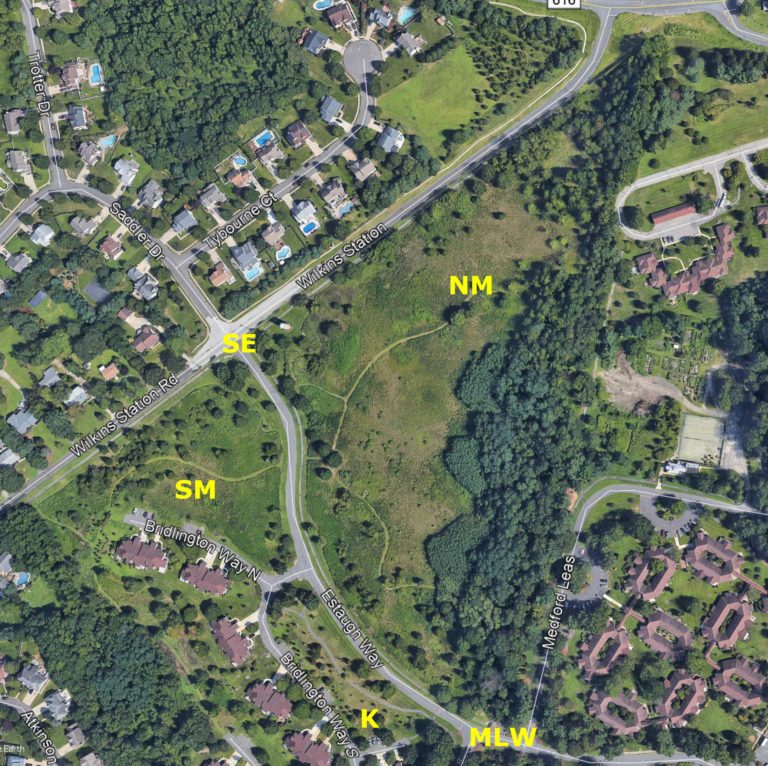Meadows
A meadow is described as a field habitat, vegetated primarily by grass and other non-woody plants. These ecosystems play a crucial role in the well-being of nature and ourselves. Within the Arboretum we are fortunate to have two meadow areas, one on each campus.
Meadows provide habitat for butterflies and other insects, birds, and small mammals and delightful vistas for residents. The open meadow spaces help to clean the air we breathe by removing pollutants. These areas also give us all a chance to be around open natural areas. Some studies suggest that activities that occur in natural settings can help to reduce stress and have positive restoration effects.
Without annual mowing, our meadows, which were farmland for over a century, would give way to pioneer trees — cedar, sweetgum, sassafras, winged sumac — and in time become forested once again. The Arboretum Oversight Committee continues to focus on the maintenance of meadow areas on both campuses.
Meadows provide habitat for butterflies and other insects, birds, and small mammals and delightful vistas for residents. The open meadow spaces help to clean the air we breathe by removing pollutants. These areas also give us all a chance to be around open natural areas. Some studies suggest that activities that occur in natural settings can help to reduce stress and have positive restoration effects.
Without annual mowing, our meadows, which were farmland for over a century, would give way to pioneer trees — cedar, sweetgum, sassafras, winged sumac — and in time become forested once again. The Arboretum Oversight Committee continues to focus on the maintenance of meadow areas on both campuses.
Lumberton Campus Meadow
The Lumberton Meadow is a retention basin surrounded by the homes on Woodside Drive (see accompanying map from Google Earth; click on the map to see it enlarged). Water moves down the slopes from the homes to a concrete gutter which carries water downhill from the top (T) of the basin through a culvert (C) down to the bottom (B) of the basin. Water then goes through underground culverts to Powell’s Mill Run (PMR), which flows through the Lumberton Campus Nature Preserve to the South Branch of the Rancocas Creek.
In the summer of 2014, a three-year project was begun to renovate the Lumberton Meadow, which had been taken over by mugwort. That summer, the existing vegetation was killed and removed. Then the entire meadow was seeded and live plants/plugs were planted in selected areas. The plan included native grasses and wildflowers to provide a wonderful and diverse landscape for both residents and wildlife. You can download a high resolution version of the plan here (a 2mb pdf).
In September 2014, after the meadow was cleared, and May 2015, as the meadow greened up, resident Terry Foss created these gigapans (huge panoramics with fascinating detail, all captured in the context of single brilliant photos) of the meadow. Clicking on a gigapan will take you to the Gigapan website, where you can zoom in-and-out and pan from side-to-side.
In the summer of 2014, a three-year project was begun to renovate the Lumberton Meadow, which had been taken over by mugwort. That summer, the existing vegetation was killed and removed. Then the entire meadow was seeded and live plants/plugs were planted in selected areas. The plan included native grasses and wildflowers to provide a wonderful and diverse landscape for both residents and wildlife. You can download a high resolution version of the plan here (a 2mb pdf).
In September 2014, after the meadow was cleared, and May 2015, as the meadow greened up, resident Terry Foss created these gigapans (huge panoramics with fascinating detail, all captured in the context of single brilliant photos) of the meadow. Clicking on a gigapan will take you to the Gigapan website, where you can zoom in-and-out and pan from side-to-side.
The photos below show the progression through the first three summers:
This gallery shows photos taken by two Lumberton residents, Robert Koch and Miriam Swartz, of some of the plants seen since the meadow was renovated (you can click on an image to enlarge it, then use the arrows at the left and right sides of the image to move to the next one):
View a slideshow of Lumberton Meadow, Spring 2018, and a gallery of “Wildflower of the Week” photos by Robert Koch.
Medford Campus Meadow
The Medford Campus Meadow is on both sides of Estaugh Way from the “Silo Entrance” (SE) on Wilkins Station Road to the intersection with Medford Leas Way (MLW). The accompanying Google Earth image shows the North Meadow (NM), South Meadow (SM), and Katzell Grove (K). The banner image at the top of this page is a view of the North Meadow looking toward the Silo Entrance.
In 2012 there was a controlled burn on the North Meadow of the Medford Campus. Click here to view brief videos and a slideshow of the burn.
Based upon the success of the work done to improve the Lumberton Campus Meadow, plans are being made to improve the Medford Campus Meadow. The ultimate goal of the project is to make the area more colorful and sustainable in terms of native plants, grasses and wildflowers. Residents, guests and local wildlife, in particular birds and butterflies, will be the ultimate beneficiaries of this project.
In the fall of 2018, a cover crop was planted in areas that had been invaded by weeds. Also, in December, a forestry mow was accomplished in an area that had been heavily wooded with Black Locusts.
The Medford Campus Meadow is on both sides of Estaugh Way from the “Silo Entrance” (SE) on Wilkins Station Road to the intersection with Medford Leas Way (MLW). The accompanying Google Earth image shows the North Meadow (NM), South Meadow (SM), and Katzell Grove (K). The banner image at the top of this page is a view of the North Meadow looking toward the Silo Entrance.
In 2012 there was a controlled burn on the North Meadow of the Medford Campus. Click here to view brief videos and a slideshow of the burn.
Based upon the success of the work done to improve the Lumberton Campus Meadow, plans are being made to improve the Medford Campus Meadow. The ultimate goal of the project is to make the area more colorful and sustainable in terms of native plants, grasses and wildflowers. Residents, guests and local wildlife, in particular birds and butterflies, will be the ultimate beneficiaries of this project.
In the fall of 2018, a cover crop was planted in areas that had been invaded by weeds. Also, in December, a forestry mow was accomplished in an area that had been heavily wooded with Black Locusts.
Early in 2019, a mow took place of the entire meadow, followed by another round of spray for invasives. As the mow took place, there were two groves of sumac that were maintained so that they could be a feature—especially in the fall season. A trail was mowed around them to keep them from exceeding their space. Another mow in early summer was followed by a raking of thatch. Mid-July, there was seeding in the areas that had previously been cleared. This seeding consisted of a blend of native grasses, perennials and wildflowers. This was followed by another mow in August.
In August 2019, the Katzell Grove was treated for weeds, and in October the area was planted with a Fescue Mix. This mix is known to be drought resistant, does not require herbicide, fertilizer and needs only minimal mowing.
Another step forward occurred in early October, as staff from Larry Weaner Associates was on site to establish what we call pop-up areas within the Meadow. These areas were designed to give us some more immediate season color with the installation of pots of perennials, as opposed to seeding. These areas were chosen primarily for visibility from the road along Estaugh Way and Wilkins Station Road, to secure maximum enjoyment for those who drive by.
In November 2019, the forestry mow area was seeded with a cover crop.
The regular mowing of the entire meadow, except for the pop-up areas, occurred in March 2020. This has been followed by additional mowing of what has become known as the previously “all kill” areas to maintain this at a height of approximately 12”. This allows sunlight to get to the ground. The pop-up areas are maintained by hand to allow for the plants to thrive and keep the cover crops to a lower height.
An assessment by staff from Larry Weaner Associates in June showed that the meadow is progressing well and according to schedule. We need to remember that even though there have been several years of work involved, the actual first seeding and planting occurred in the Fall of 2019.
The summer of 2020 includes weed monitoring as well as selective mowing.
As we entered into 2021, the annual mowing of the full meadow took place in January. An early complete mow was done to minimize wildlife disturbance and to take advantage of frozen ground. The mow does not include the patches of sumac that have been preserved to enhance fall color.
The pop-up gardens had an additional mowing in March 2021. A grove of sweet gums that had become invasive in the meadow near Bridlington were cut flush to the ground to eradicate this grove.
Through 2021 the meadow has continued to grow and fill in. The area is regularly treated with spot spraying for invasive so that they do not take over the meadow.
In September, the warm season grasses have taken off providing movement as the wind blows through the meadow. In addition, plumes of Blue Mist flower and Goldenrod are coming into bloom.
As one might expect, there are some areas of Lespedeza in the meadow, which will be treated this fall. The tall boneset, although native, is spreading. The challenge it presents is that it limits the views into the meadow from some of the perimeter paths. This will be spot-sprayed to provide a buffer of 15 feet from the edges to provide an easier site line.
Photos from a morning walk through the Medford campus meadow (no audio).
We continue to work with Larry Weaner Landscape Associates (LWA) as our consultant and guide on this project. LWA is nationally recognized for combining environmental science with the rich artistic traditions of landscape design. We have appreciated their guidance and support over the years.

